Text
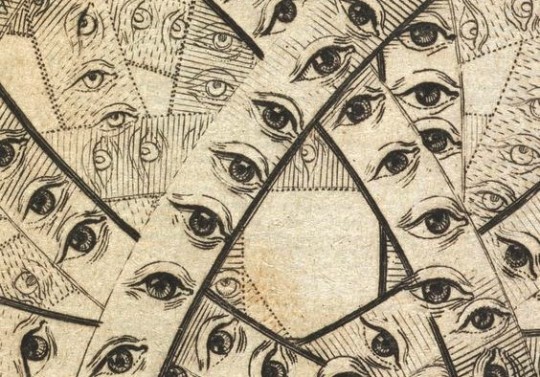
The Angelic Hierarchies
The word “angel” (meaning “messenger”) is an umbrella term for a vast category of different species of spirits; but due to the rise of monotheism, these spirits were written as simplified entities in order to hide the truth of what they are. This information is an account of my experiences in the astral and of communing with these fascinating spirits in order to learn about them. This topic is extremely complex, so the following will be general knowledge.
History of the Angels:
As stated above, “Angel” is an umbrella term for many different spirits. Therefore, Angel is not a species but a title for many different groups of spirits who work with one another. The “types of angels” (Archangel, Cherub, etc) are not different species, but different job titles. There are however beings in this group called “angels” who are their own species and act solely as messengers, but this will be discussed later on.
The Source (called Atum in Egypt and Brahman in India) is the beginning of all things. They have always existed and they are formless. The Source is the supreme god who is pure consciousness and is all-powerful and all-wise, as well as the creator of the first gods, who became the first Angels. The counterpart to Atum (Source) is the Queen of Heaven (the Cosmic Womb) who was created from Atum and then she embodied pieces of herself into all of the goddesses (some more than others). When this Universe was created, Lucifer was the firstborn god who emerged as burning and radiant light. After many ages, more gods were created as well, and they were led by Lucifer.
As time went on, more beings came into existence, with additional gods and semi-divine entities called angels (the humanoid messenger species) being created from the elder gods. The Angels who emerged from the farther reaches of the Universe look more alien in appearance; these are the ones who have multiple wings and eyes. With all this, Atum granted roles to these trusted beings and made them Angels (agents of the Source) with different categories which contained different roles based off their personal specialties. Plenty of Angels were granted more than one role (so some are both Archangel and Seraph, etc).
When the day came that a powerful creator god named Jehovah arrived, he attempted to usurp the Earth and the Throne of the Universe, which sparked the rebellion of many Angels. After a painful and horrible battle, Jehovah succeeded and banished the rebels into the nightmarish realm of Hell after destroying their homeland, then he continued to Earth where he presented himself as the Source. Here he manipulated humans into destroying one another and betraying their own gods. Since the purpose of Existence is to learn and evolve through trials, the Source allowed this and observed the actions of both gods and humans alike as they struggled. This should not be mistaken as being uncaring, as the Source can see all things and possibilities; their mind is utterly incomprehensible and strategic.
The First Sphere:
The following three categories of Angels are the closest to the Source and can best understand the Divine Will. They are made up of the following categories:
Seraphim: These are the highest of the Angels and their role is to manage the Watchers and act as wise mentors towards Illumination. The Seraphim (meaning the “flaming serpents”) are made up of both gods and dragons (mostly dragons) and they dwell in a realm of ever-lasting fire where they can be seen flying through enormous flames. Some of these gods don’t look human at all, while others (like Lucifer) appear humanoid. The leader of the Seraphim was Lucifer, before he Fell during the rebellion.
Other notable members: Satan and Azazel (also a Watcher).
Lucifer as an Angel had several different roles and is the most complex and beautiful of all the Universal gods, with his wife Lilith as his only equal (as she embodies the Queen of Heaven). He held the role of leader of the Seraphim, was also an Archangel, and he was a Destroying Angel as well. When he was banished to Hell by the Usurper, he became one of the three High Kings (the other two being Satan and Leviathan), with each owning their own kingdom. These entities did not turn evil (only became more dark in nature due to trauma), but were wrongly accused of many things by a tyrant god who sought to diminish them.
Cherubim: These entities serve as guardians and soldiers. They are steadfast protectors of a great many things, including gates, doorways, the arts, sacred locations, etc. They are made up of the following different spirit species: lamassu, sphinxes, griffins, and angels. This is why many ancient cultures built statues of these beings at special locations. A notable member of this group is Gabriel (she is also an Archangel and is the co-leader of the Celestial army). A notable (ex) member is the demon Belial, who had joined Lucifer during the rebellion.
Thrones: These Angels hold the role of passing on decrees from Atum (Source) and of teleporting the other Angels from one area of the Universe to the other. The Thrones are all deities who appear as giant rotating spheres of rings with many eyes.
The Second Sphere:
These categories of Angels act as mediators for the 1st and 3rd Spheres.
Dominions: This group of entities hold the role of supervising virtues and assisting mortal beings in becoming more morally aware and wise. This group is made up of the following spirit species: gods, dragons, and angels (messenger deities and semi-divine beings).
Virtues: This group teaches virtues (such as compassion and courage) to mortals in ways that they can understand. This group is made up of both gods and angels.
Powers: These Angels solidify energy beams from Atum in order to perform specific magick, which they then give to the Principalities and Archangels, who then use it to assist mortals. The entities who are part of the Powers category are gods and angels.
The Third Sphere:
These categories of Angels work the most closely with mortal beings, as their roles are to assist in guiding, teaching, defending, and even destroying.
Principalities: These entities hold the role of organizing and guiding Platonic ideas (love, faithfulness, determination, etc) to mortals. Principalities also assist in the Universal Song, which creates everything. This group is made up of the following spirit species: gods, dragons, angels, and elves.
Archangels: This group of Angels is entirely made up of gods (elder and lesser) who hold various different roles such as planetary guardians, military leaders, and mentors to mortals. Some notable members include Lucifer (ex member), Mikael, Anael, Gabriel, Raphael, Asariel, Azrael, Kamael, Sandalphon, Tzadkiel, Tzafkiel, Raziel, and Metatron.
Angels: These are the lesser gods and semi-divine race of beings who operate as messengers and helpers to mortals. They comprise the majority of the Angels known to humans (with the exception of the notable Archangels). The angels appear as humanoid beings with white wings.
Watchers: This is yet another umbrella term for a vast category of different roles for Angels upon the planets. Overall, Watchers (Zophim) hold the role of protecting mortals and acting as their wise mentors. A large amount of the Watchers fell in love with humans, with whom were born the Nephilim (demi-gods). The species of entities who make up the Watchers include gods, dragons, and angels.
There are different categories for specific jobs of Watchers since some are guardians of mortals, some watch over life-process, and others teach different things to mortal beings. The leader of the Watchers was originally Azazel, who was punished by the Usurper (Jehovah) for falling in love with a human woman. As punishment, Azazel was splintered in half, with his other self becoming known as the demon Paimon. So while Azazel is more fiery and impulsive, Paimon is more calm and level-headed.
Other notable members: Tiamat and Leviathan (ex member) - both of these are draconic deities.
Additional Information:
When an Angel loses their status, there are two things they can become known as: a fallen or a demon. Most people are confused due to religious texts implying that all fallen angels went to Hell, but this is not quite so. The severity of the reason behind the Fall determines the fate of the Angel, as well as if they defied the Usurper or not. The following describes the differences:
Fallen: An Angel who did not participate in the Rebellion against Jehovah but instead fell due to other reasons. These reasons can be many things such as turning corrupt, neglecting divine duties, betraying orders, etc. They do not have their forms change to become more dark and intense the way demons do.
Demons: These are the Angels who participated in the Rebellion against the Usurper, Jehovah (although many demons are the children of other demons, and so were born into this race). They were punished by him by being thrown into Hell- a land where unspeakable horrors are that can drive most humans mad upon seeing them. The three gods Lucifer, Satan, and Leviathan took over different areas of this vast land and built their own kingdoms, planning the continuation of the long war against Jehovah. Due to their banishment to Hell, the demons became made of different energy than Angels and changed in appearance to have blackened wings and horns.
Despite what religious texts say, Hell is meant only for the truly evil beings and it does not matter what religion they have (even a Christian will go to Hell if they are corrupt). So the demons are basically the sacred rebels who teach Illumination through adversity, for change and rebirth can only be gained through suffering. They are punishers of the wicked and stand for freedom, strength, and truth.
797 notes
·
View notes
Text

In western mythos, we are mostly familiar when a feminine moon and masculine Sun. In certain traditions around the world, especially in folklore concerning solar eclipses, the sun is instead feminine and the moon is masculine:
In Norse mythology, the solar goddess Sol and lunar god Mani are sister and brother.
In Tahitian myth, the Sun goddess and mother of rice, Padi, and the dark moon (each moon phase has varying names) are lovers who are said to be getting ‘lost in the moment’ when they create a solar eclipse.
Inuit lore has told of the Sun goddess Malina being chased across the sky by her brother, the moon god Igaluk. Occasionally he catches up with her for a brief reunion and everything goes dark.
In the indigenous Euahlayi stories from Australia, the Sun is a woman, Yhi, and the moon as a man, Bahloo. Yhi falls in love with Bahloo and chases him across the sky. Yhi tells the spirits that hold up the sky that if they let Bahloo escape then she will plunge the world into darkness. So during a total solar eclipse, medicine men traditionally chant to connect with the spirits of the sky to allow the moon, Bahloo, to continue to enchant and Yhi in this celestial chase.
I made this illustration adapted from my tattoo flash for Magic PJ’s PMU & Tattoo to share this with you.
7 notes
·
View notes
Text
Cyrene: *fighting lions with her bare hands*
Apollo:

266 notes
·
View notes
Photo

man pent-up “I NEED TO ART” energy finally getting an outlet sure is a thing innit
38 notes
·
View notes
Text
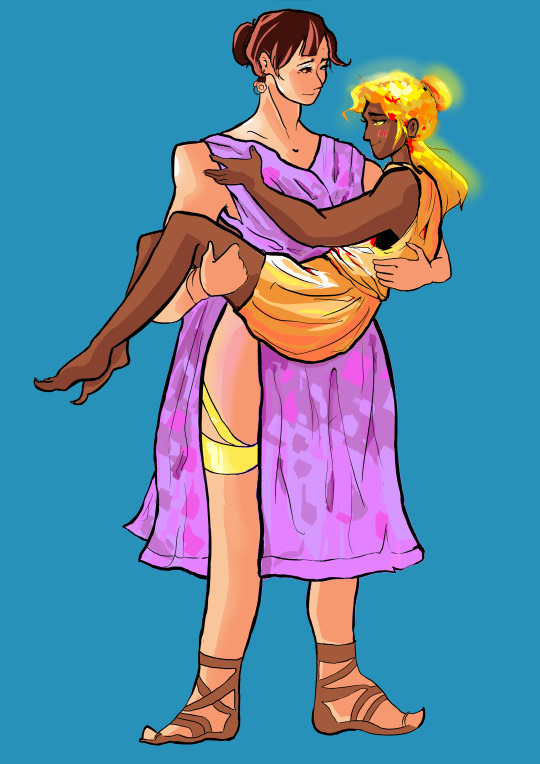
i keep forgetting that i have this account. made this for @firealder2005. Am very excited for your project <333
105 notes
·
View notes
Text
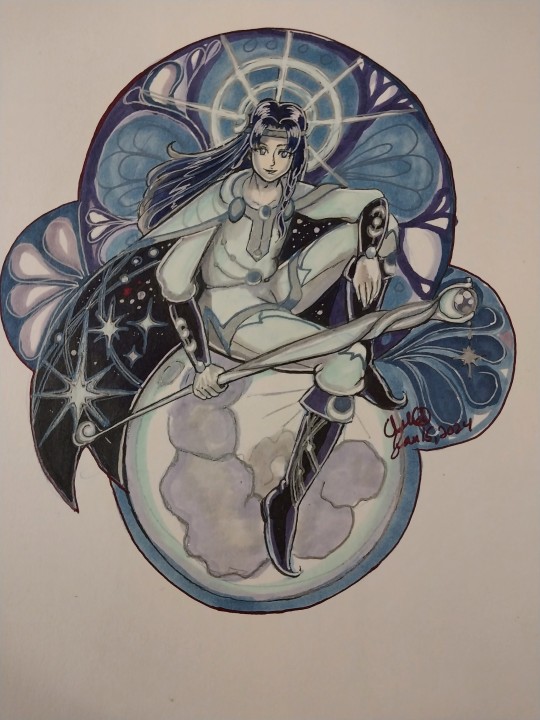
Mani, the Norse moon god. I did the line art a little while ago and finally colored it in.
19 notes
·
View notes
Text
For the sun and the sky (hellenistic prayers)
To Apollon, for the sun and its glory and warmth, sustaining life on Gaia’s surface and bringing us joy when we turn our faces to the sky. Thank you for the path of your chariot across the heavens, where we may see you and rejoice.
To Helios, holy life of the sun; thank you for your presence so close and so far from us, perfectly balanced to bring warmth and light to our fragile planet.
To Ouranos, holy life of the sky and the atmosphere; thank you for shielding us from the cold of space and bringing air to our lungs. Thank you for guiding the clouds to part today, so we may see the light of your fellow gods.
To Hemera, holy life of the day; thank you for the turn of the Earth that brings your presence to us, blessing us with light for work and play and all of our lives.
Εύχαριστω καλο και ισχύρος θεοι.
261 notes
·
View notes
Photo

Preview to this term’s Sketch Paper Character Q&A
… … … … … … … … … … … …
♥Support me on Patreon ♥
♥ Read my web-comic on TAPASTIC ♥
*Currently updating: MYth: Inflammation
182 notes
·
View notes
Photo
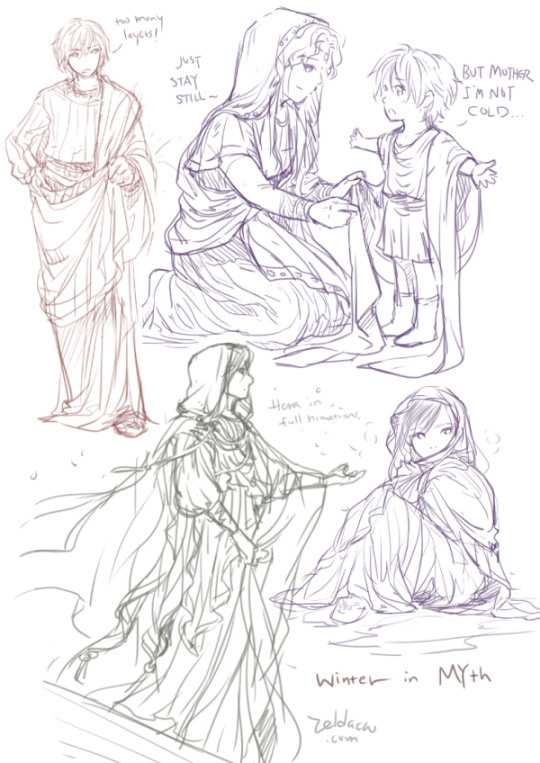
Sketched some winter clothing (long dress, draped/ full himations based on ancient Greek attire) Although the palace of Mt. Olympus doesn’t get affected by season temperature changes….but just in case they feel cold for some reason….XD
… … … … … … … … … … … …
♥ Read MYth comic | Zeldacw on Patreon | Shop for prints & more ♥
211 notes
·
View notes
Photo

Pleione (Grandmother of Hermes)
*from Dec. 2015 Patreon Weekly Sketches
… … … … … … … … … … … …
♥ Read MYth comic | Zeldacw on Patreon | Shop for prints & more ♥
205 notes
·
View notes
Note
For the character breakdown, I’d love to see hadad, anat, shapash, yam, mot, athtar, kothkar and khasis... really any of the ugaritic pantheon, of course you don’t have to do all of them >.<, I’d just love to see your hot takes
I shall rise up to the challenge! I’m the only person on this site obsessed with Ugarit as far as I can tell... I covered everyone you asked for plus Ashtart and Yarikh.
As much as I like burrowing through jstor and academia edu and persee and so on, I kind of wish there were more people approaching Ugaritic, Mesopotamian, Hittite etc. myths the way many do with Greek ones tbh - sometimes i’d just like to see which figures people think would be into gossiping and so on or which tacky modern fashion they think suits them equally as much as I want to find out if Yarikh’s portrayal in Ugaritic poetry owes more to Nanna/Sin or to the Hittite moon god.
ALSO as far as this sort of light hearted takes go, there are two japanese artists on twitter who draw Baal cycle fanart: here and here.
Hadad:
How I feel about this character: one of my fave mythical protagonist. I think I genuinely only like Inanna more. Going from a very relatable desire to get his own house to triumph over death is quite the journey. The relative powerlessness many interpreters point out is interesting, too - the fact he mostly gets somewhere because of allies and because even if El was the king of gods, Hadad’s attributes made him the king of people’s hearts arguably, so he has to win against overwheming odds.
All the people I ship romantically with this character: Anat, Ashtart/Astarte/however we transcribe her name this week... Kothar?
My non-romantic OTP for this character: given the Seth-Baal equation in Egypt and the uncertaininty over whether Astarte papyrus is about Seth or Baal under Seth’s name it’s funny to imagine them as friends. Also I’ll talk about it more underneath but since Dagan was a god with similar purposes further inland (and is attested earlier iirc) and Ugaritic texts - even though they rarely feature him - call him Hadad’s father - it would be cute to assume he also taught Hadad everything.
My unpopular opinion about this character: I’m a Dagan parentage truther against all odds. It was the norm outside Ugarit! I think “Dagan isn’t in Ugaritic myths because they take place in Ugarit but people thought Dagan lives further inland in Tuttul based on prayers etc.” is enough to explain his absence from myths, and also note that in the epic Baal is “Dagan’s son” even when he’s at a low point (ex. when Yam demands he gives up his freedom or when he’s dead) and only El’s and Asherah’s son when he’s victorious for the most part (ex. during palace construction) - imo this makes it plausible that Dagan is his real dad and El and Athirat are only his parents in the way vassal rulers called emperors fathers. Likewise I think any references to siblings can be interpreted in the light of ex. kings of Ugarit calling kings of Carchemish or Alashiya brothers.
One thing I wish would happen / had happened with this character in canon: I really like how corny the Hittite/Hurrian storm god cycle is with Kumarbi constaly raising new challengers to attack Kummiya and dethrone Teshub/Tarhunna, I actually wish the Ugaritic one was longer too via a similar plot device. Also I wish Dagan actually appeared in myths alongside his son - Noga Ayali-Darshan had a theory he was in some oral tradition predating Baal cycle as the god announcing Yam demands a tribute since in Hurrian “Song of the sea” and in Egyptian “Astarte papyrus” a grain deity does this but a possible reconstruction isn’t much...
Anat
How I feel about this character: well, she’s not Inanna, but she’s still pretty good. I mostly like the parts of the Baal narrative which show her unpredictable character, like her probable parents being afraid of her, listing various never shown enemies she vanquished, or Mot’s death. Aqhat myth doesn’t interest me much. That myth fragment where she and Ashtart pity Yarikh because other gods treat him poorly is interesting, too.
All the people I ship romantically with this character: Baal, Ashtart, that’s it I think.
My non-romantic OTP for this character: she seems to get along really well with Shapash during the segment of the Baal cycle where Baal is dead.
My unpopular opinion about this character: I really hate the speculation popular among bible scholars which amounts to making her, Ashtart and Athirat interchangeable to justify her irrelevance in the iron age.
One thing I wish would happen / had happened with this character in canon: honestly? I wish an “Anat cycle” existed. She pretty clearly had a fair share of own adventures considering Baal enlists her help on the account of past accomplishments.
Yam
How I feel about this character: out of all antagonists in the basic middle eastern “storm god vs sea” narratives I think he has the most fun personality - Hedammu is barely a “character” and Tiamat lacks the more human dimension Yam has.
All the people I ship romantically with this character: nobody, he has to move past the Astarte papyrus characterization and learn some respect for that smh
My non-romantic OTP for this character: his nameless rude messenger who refused to bow down when speaking to the assembly of the gods
My unpopular opinion about this character: contary to what this (very good) paper says, the Yam battle is more thrilling than the Mot one - the strength of the Mot part of the narrative comes from the visceral descriptions of Anat’s emotions but Mot is a flat villain compared to Yam.
One thing I wish would happen / had happened with this character in canon: he had a seemingly positive role in cult and there are 13 known people with Yam theophoric names (out of 6000 or so people from Ugarit known by name) so I sort of wonder if there’s some lost myth where he’s the hero or something.
Mot
How I feel about this character: if nothing else, feeling offended by being offered bread and wine instead of corpses is pretty funny and a great introduction. And the pathetic attempt at a comeback shut down by Shapash is
All the people I ship romantically with this character: unshippable by design tbh.
My non-romantic OTP for this character: if the theory about Horon - the god from the “anti-snakebite text” and the “may horon crack your skull” curse - being a cthtonic god too - just a generally benign one - is true I think they could have a lot of comedic potential.
My unpopular opinion about this character: I don’t understand where the idea of a nonexistent myth about Mot kidnapping Shapash and Yarikh comes from and I wish it wasn’t all over the place online.
One thing I wish would happen / had happened with this character in canon: some more detailed description of the afterlife - Mot, rephaim, Horon if he really lives there - would be useful...
Shapash
How I feel about this character: she seems severly... underrated? There are maybe two papers about her (and one underlines the fact there isn’t much research on her) and yet she’s the second most prominent goddess in the Baal cycle AND has her own narrative in the anti-snakebite texts! She might actually be more remarkable than her Mesopotamian counterpart - with all due respect for Utu/Shamash, in myths he’s the boring sibling between himself and Inanna/Ishtar...
All the people I ship romantically with this character: I don’t have any real ideas, some papers assume she and Horon were a thing but this is disputable and Horon is pretty nebulous himself...
My non-romantic OTP for this character: “Kothar - your close friend!” from that one hymn has that covered. Since she’s basically a divine herald perhaps they travel together?
My unpopular opinion about this character: I suspect the reason why she isn’t studied more is because many researchers are stuck with some sort of false “good mother goddess - evil sex goddess” dichotomy of ancient middle eastern religion and while you can force Athirat, Anat and Ashtart into these roles, Shapash with her aura of a divine equivalent of a mundane earthly official doesn’t fit into it and as such is ignored.
One thing I wish would happen / had happened with this character in canon: I said I hate the false Mot myth spreading online but I actually do wish there was a myth or at least a cult text of some sort showing what sort of relation existed between her and Yarikh - safe to say it didn’t mirror Shamash and Sin...
Kothar-wa-Khasis
How I feel about this character: huge fan of artisan gods and he seems genuinely nice. One of my Ugaritic b-list favorites. I like that he’s a reneissance man - armorer, architect, even a musician... The theory that he was developed based on Ptah since Memphis had a large foreign population is great.
All the people I ship romantically with this character: Baal sort of? I imagine Baal is actually relatively knowledgeable about architecture given the length of the window debate in the Baal cycle...
My non-romantic OTP for this character: Shapash, as I said earlier.
My unpopular opinion about this character: based on the tale of King Keret some researchers argue he’s meant to be ugly like Greek Haephestus, but since I like the Ptah theory and his appearance isn’t described elsewhere AND King Keret might be satire where everyone is their worst self possible, I prefer to imagine him as handsome
One thing I wish would happen / had happened with this character in canon: supposedly from Caphtor and yet we never see Caphtor (Crete) in Ugaritic myths... come on, ancient scribes, surely someone went there? Maybe even recorded some proper Minoan myths?
Ashtart
How I feel about this character: she’s my favorite Ugaritic figure of limited relevance. An Ishtar/Inanna equivalent who seemingly curses other gods and presides over political pacts is a pretty solid premise! And it’s funny she rebukes Baal seemingly for insufficient dedication in battle. I wonder if the Egyptian fragment which implies Yam acted lecherous towards her is a factor in this tbh. Perhaps an earlier oral tradition had both these elements...?
All the people I ship romantically with this character: Baal (her title is “face of baal”/”of the name of baal”, c’mon...), Anat (almost always listed together!)
My non-romantic OTP for this character: Keret curses his son with a formula invoking both Horon and her so perhaps that’s who she’s learning curses from.
My unpopular opinion about this character: I hate that “Astarte is Asherah” is widespread just because people want to defend the historicity of the biblical Jezebel narrative which probably even the biblical compilersdidn’t view as historical.
One thing I wish would happen / had happened with this character in canon: I wish she didn’t vanish from the Baal cycle after Yam’s defeat :C
Attar
How I feel about this character: this sure is... a guy. He’s so pathetic in the Baal cycle it’s hard to even see him as an antagonist - sorry, Handbook of Ugaritic Studies...
All the people I ship romantically with this character: nobody, Shapash points out he’s single as the reason why he can’t rule and i don’t think that changes in any subsequent texts? But then Marriage of Nikkal and Yarikh iirc mentions he has a daughter...
My non-romantic OTP for this character: again, nobody.
My unpopular opinion about this character: he’s actually a pretty vital part of the Baal cycle and the fact he gives up on own accord makes him more interesting than the other “failed god” in a similar narrative, Ashtabi.
One thing I wish would happen / had happened with this character in canon: a god with the same name was prominent in present day Yemen so I guess finding some direct connection would be nice - it fits with him leaving to “rule elsewhere” in the myth!
Yarikh
How I feel about this character: he’s so pitiful in the fragment which compares him to a dog begging for scraps... His main myth is pretty good too, tbh it’s the best middle eastern marriage myth imo - I actually don’t care for Dumuzi much, but Yarikh is cool.
All the people I ship romantically with this character: only Nikkal-wa-Ib
My non-romantic OTP for this character: given his mistreatment and Nikkal’s father(?) saying he could be a son in law of Baal I assume that in some unknown texts they must have been allies. Note that the Hittite storm god has the sun and moon gods acting as his metaphorical eyes warning him against Kumarbi’s new plots in song of Ullikummi. Also I assume Anat and Ashtart must consider him a friend given how they help him when nobody else does? All around he feels like a god in Baal’s orbit even though we have 0 direct proof for it.
My unpopular opinion about this character: I think trying to correct him to Nanna is a doomed endeavor tbh. Their wives have similar names but Yarikh doesn’t give the impression of a “Father of gods” type deity in what little we know about him.
One thing I wish would happen / had happened with this character in canon: more myths. None we know show him as the moon even though it’s literally his name!
I am afraid I don’t have anything interesting to say about El and Athirat. Handbook of Ugaritic Studies has an amazing El summary that I generally stick to, I can post a cap if you are interested.
19 notes
·
View notes
Text
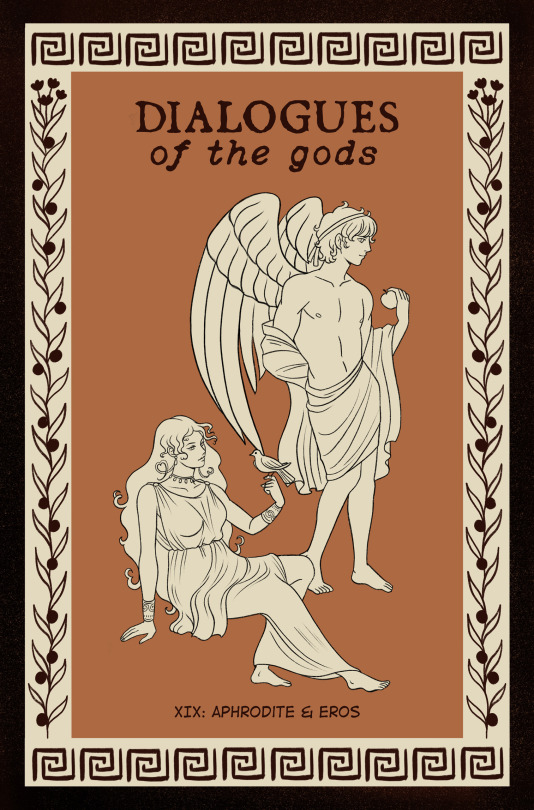


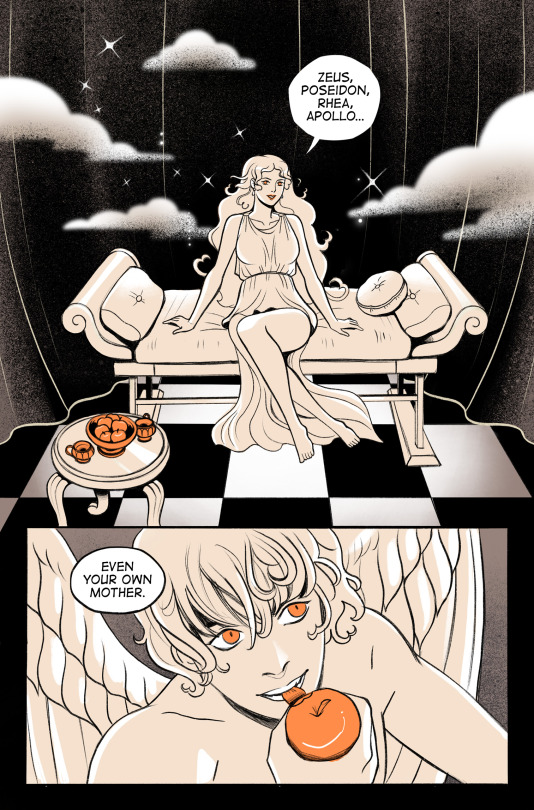
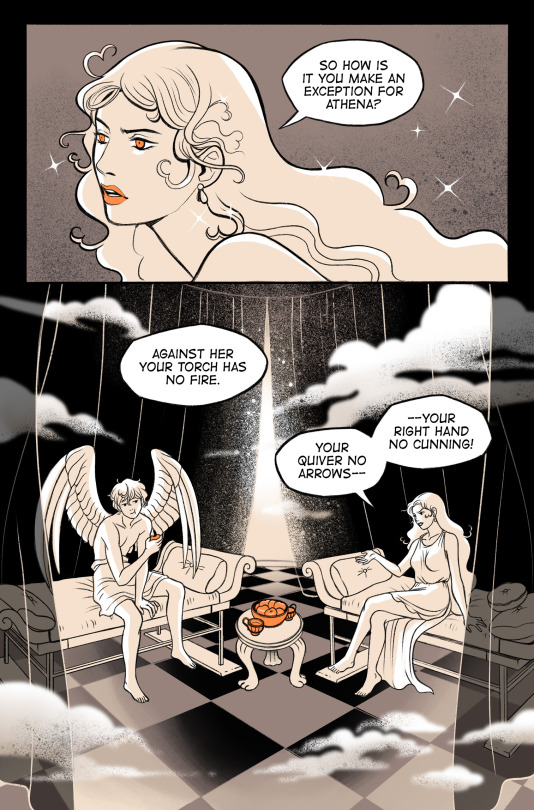




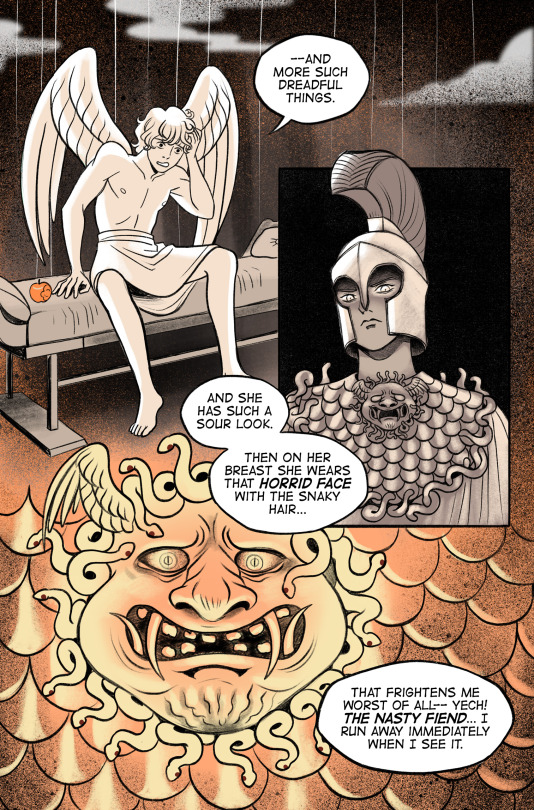
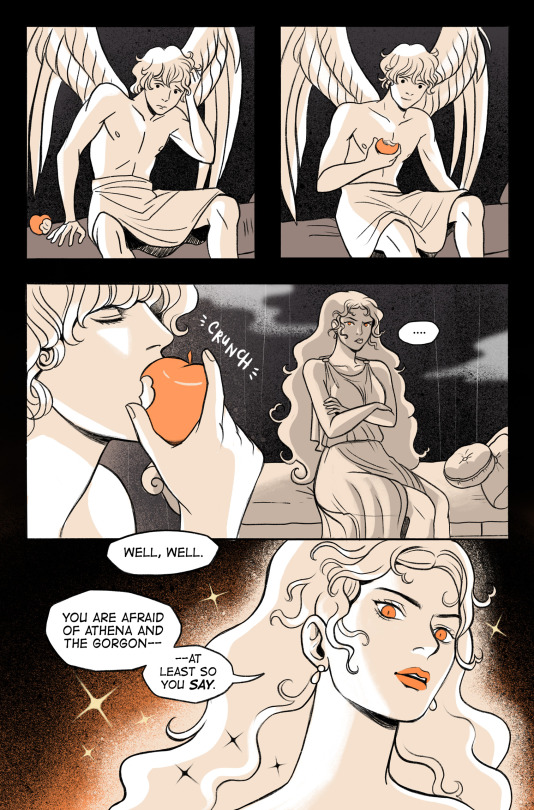
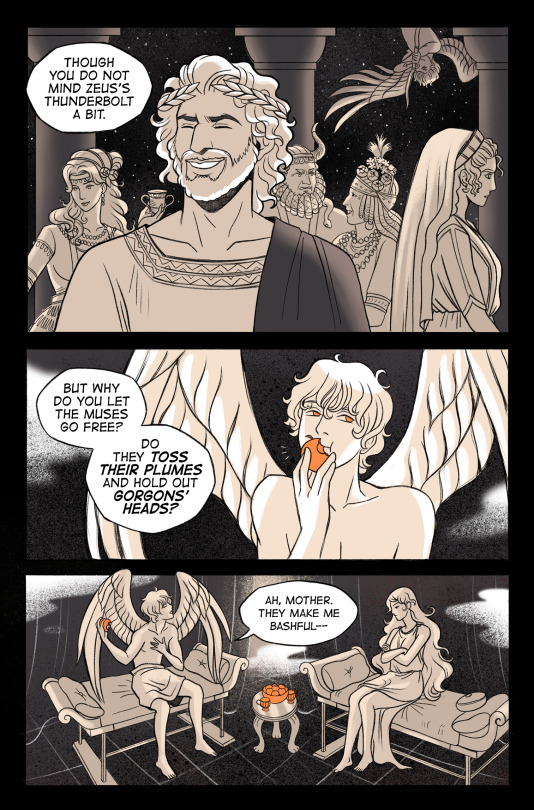

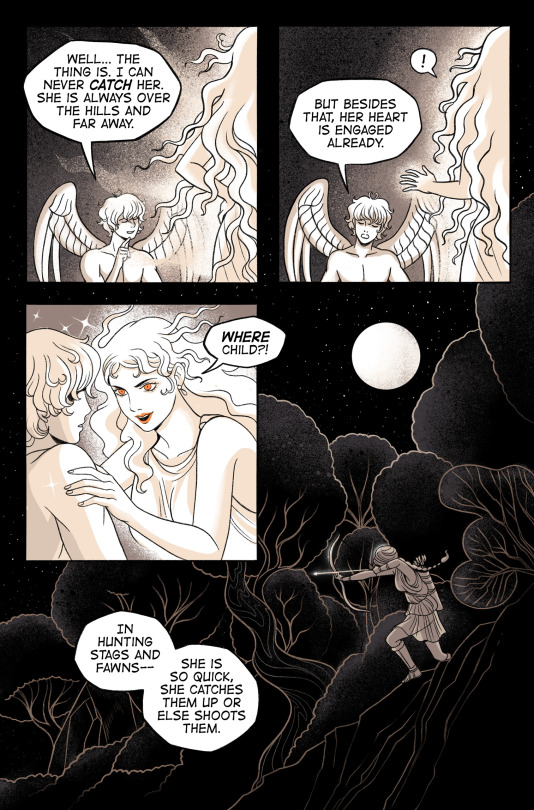
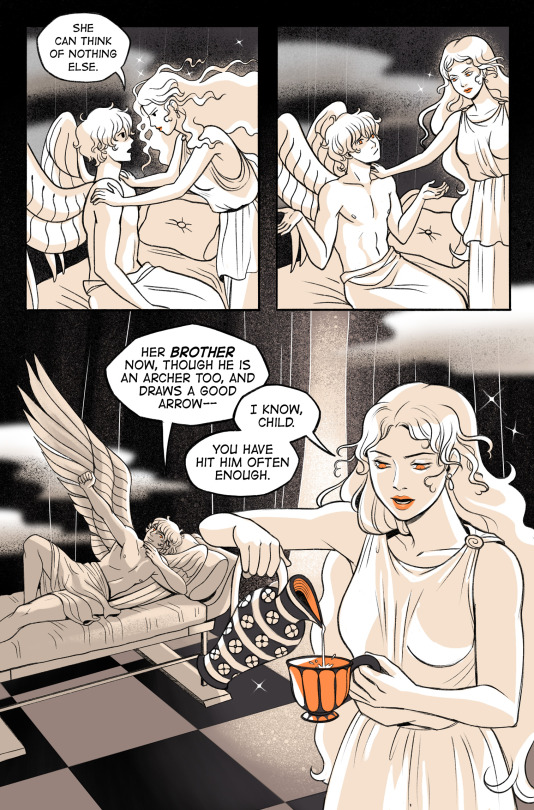
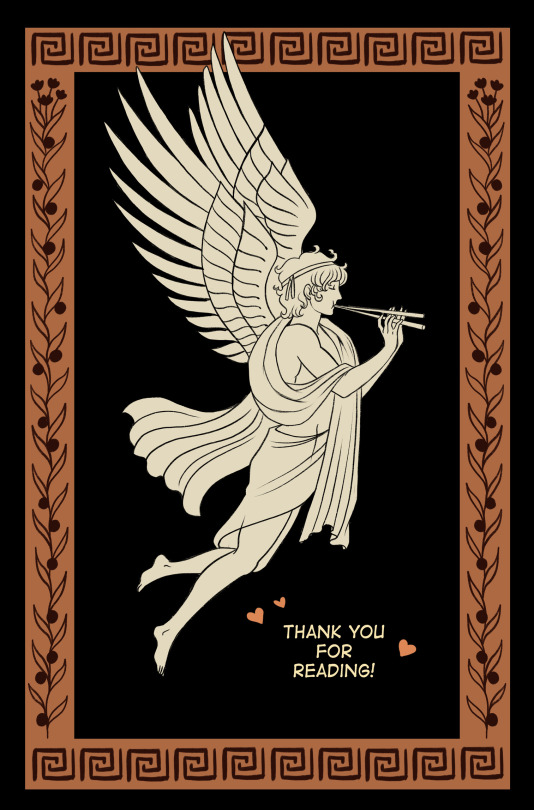
*Notes:
I love making comics but find the writing process difficult, this is something I need to work on, as I have so many ideas but struggle to write them out. I stumbled upon Lucian's Dialogues on Tumblr and thought his charming, tongue-in-cheek style would be a good way for me to practice my comic-making. :')
"Lucian of Samosata was a Greek satirist who flourished in the region of Commagene near Syria in the C2nd A.D. He was the author of numerous works, which include: The Dialogues of the Gods, Dialogues of the Sea Gods, and Dialogues of the Dead."
I opted for a simple color scheme because as much as I love full-color comics, it would take me so much longer to get this done.
-----
Support my work:
Get early access to art, comics, and digital downloads by joining my Patreon! ✨🌿
I also have an Etsy where you can purchase stickers and prints.
-----
Social Media:
Instagram | Bsky
1K notes
·
View notes
Photo
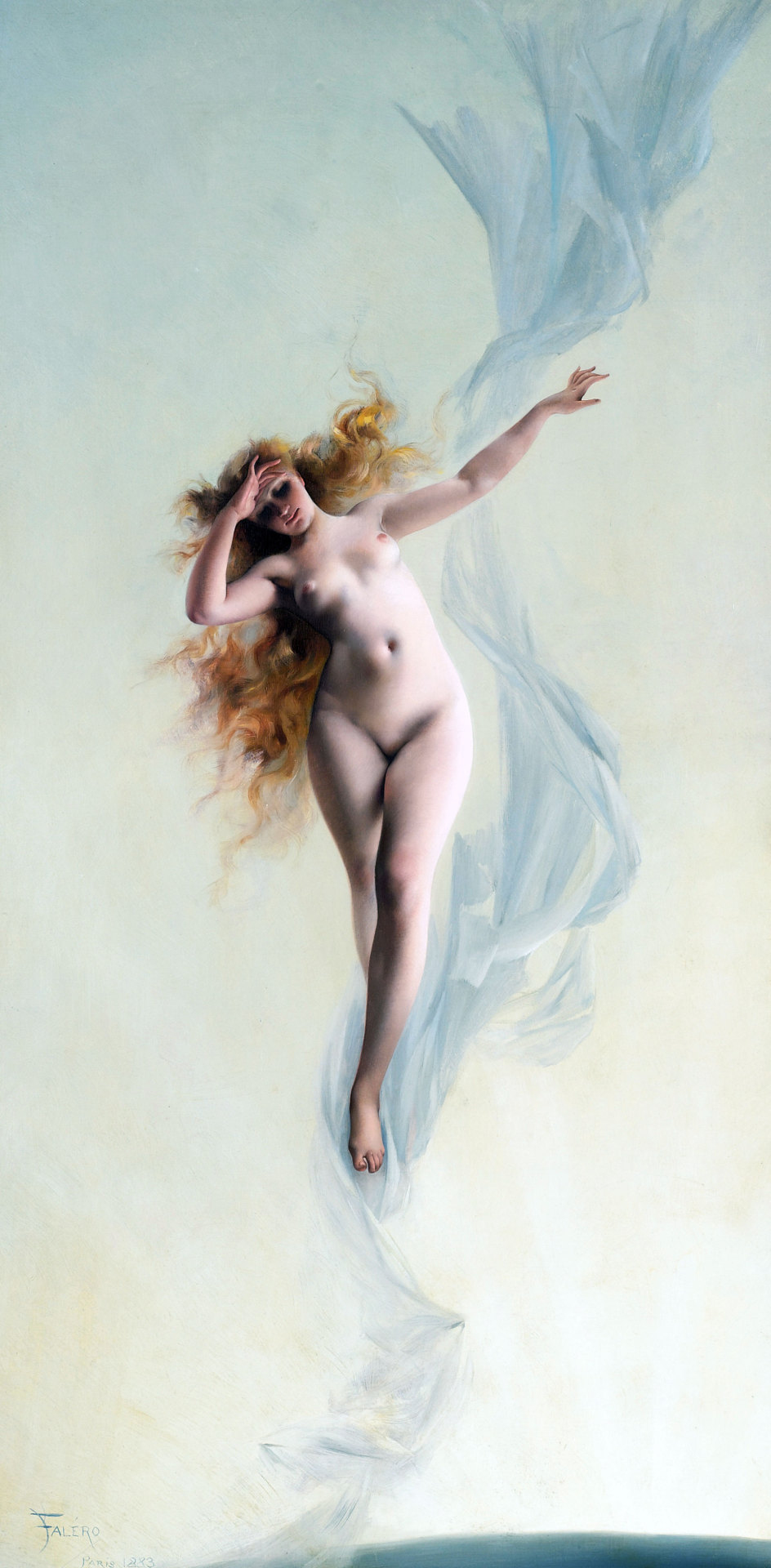

Falero, Luis Ricardo. Dawn. 1883. Oil on canvas on panel. Paris, France.
Falero, Luis Ricardo. Diana. 1883. Oil on canvas. Private Collection, n.p.
4K notes
·
View notes
Photo
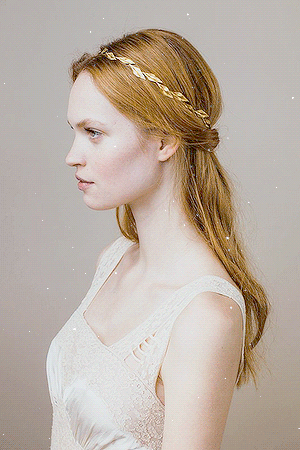



Eos (Éōs meaning “dawn”) was a Titaness and the goddess of the dawn, who rose each morning from her home at the edge of the Oceanus in Greek Mythology. She had a brother and a sister, Helios, god of the sun, and Selene, goddess of the moon and was almost always described with rosy fingers as she opened the gates of heaven for the Sun to rise. In Homer, her saffron-coloured robe was embroidered or woven with flowers rosy-fingered and with golden arms, crowned with a tiara or diadem and with the large white-feathered wings of a bird.
871 notes
·
View notes
Text

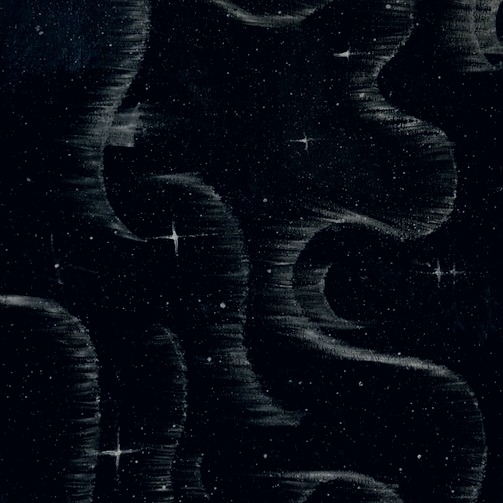
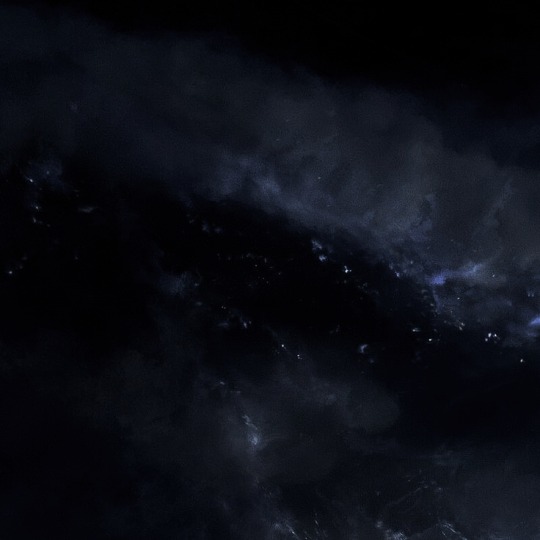


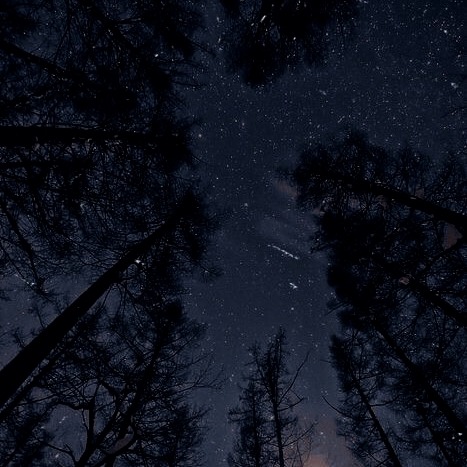
ㅤ❛❛ㅤㅤㅤ𝑨𝑺𝑻𝑹𝑨𝑬𝑼𝑺 , 𝑶𝑭 𝑻𝑯𝑬 𝑺𝑻𝑨𝑹𝑺 .
Astraeus was a Titan god in Greek mythology, son of the Titans Crius and Eurybia. He was the god of the dusk and the winds. Astraeus was married to Eos, goddess of the dawn, and created numerous children, including the four Anemoi (winds) and the five Astra Planeta (wandering stars or planets).
56 notes
·
View notes

